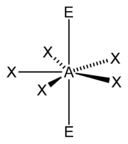Notes on Chemical Bonding
Chemical bonding is a fundamental concept in chemistry
that explains how atoms combine to form molecules and compounds. There are
several types of chemical bonds, each with its own characteristics and
properties.
Types of Chemical Bonds:
Ionic Bonds:
An ionic bond is a type of chemical bond that forms between two atoms with significantly different electronegativities. It is formed considerably between metals and nonmetals. Such bonds are formed when one or more electrons are transferred from one atom to the other.
Examples:
Common examples of compounds held together by ionic bonds
include sodium chloride (table salt), potassium chloride (used in some salt
substitutes), calcium carbonate (found in chalk and shells), and magnesium
oxide. The figure below explains how sodium ion looses one electron which is
accepted by chlorine atom. Thus sodium becomes a cation and chlorine becomes an
anion. An electrostatic force of attraction between these two ions is called
the ionic bond.
Here are the key
characteristics and properties of ionic bonds:
1.Electronegativity Difference:
Ionic bonds typically form when there is a large
difference in electronegativity (the tendency of an atom to attract electrons)
between two atoms. One atom, usually a metal with low electronegativity,
donates electrons to another atom, typically a nonmetal with high
electronegativity.
2.Formation of Ions:
The atom that loses electrons becomes positively charged
and forms a cation. The atom that gains electrons becomes negatively charged
and forms an anion.
3.Attraction of Opposite Charges: The
electrostatic attraction between the positively charged cations and negatively
charged anions is what holds the ions together. This attraction creates a
strong bond.
4.Physical Properties:
a.Ionic compounds tend to have high
melting and boiling points because the electrostatic forces between ions
require a lot of energy to overcome.
b.They are typically solid at room
temperature.
c.Ionic compounds are often brittle
because when pressure is applied, like charges align and repel each other,
causing the crystal lattice to break.
5.Solubility:
Ionic compounds are often soluble in polar solvents like
water because the polar water molecules can surround and stabilize the ions,
allowing them to separate and disperse.
6.Electrical Conductivity:
In the solid state, ionic compounds do not conduct
electricity because the ions are held in a fixed lattice structure. However,
when melted or dissolved in water (forming an electrolyte solution), they can
conduct electricity because the ions are free to move and carry electrical
charge.
7.Crystal Lattice Structure: Ionic
compounds typically have a three-dimensional crystal lattice structure in which
ions are arranged in a repeating pattern.
8.Transfer of Electrons:
In an ionic bond, electrons are essentially transferred
from one atom to another. The atom that donates electrons becomes a cation,
while the one that accepts electrons becomes an anion.
Lattice energy:
The amount of energy released when one mole of an ionic compound is formed
from its constituent ions is called the lattice energy of the compound.
Higher is the lattice energy of a compound higher is its
stability.
Lattice energy depends on the following two factors:
a.Size of ions: The strength and stability
of ionic bond is inversely proportional to the size of ions. If the size of
ions is small, the inter-ionic attraction increases and more energy is released
in the formation of the comp[ound. The ionic bond becomes stronger and stable.
For example the size of Na+ and K+
ions are 0.95A0 and 1.33A0 respectively. This is why the
ionic bond in NaCl is stronger than that in KCl.
b.Charege on ions: Greater is the charge
on ions greater will be the inter-ionic attraction. Greater energy is released
in the formation of compound. The ionic bond becomes stronger and stable.
Calculation of Lattice energy using Born-Haber Cycle: The
Born-Haber cycle is a way to calculate the lattice energy of an ionic compound
using a series of steps and Hess's law. It's a theoretical framework that helps
us understand the relationship between the energy changes involved in various
processes such as ionization, sublimation, dissociation, and formation of ions
and compounds. The cycle is named after two scientists, Max Born and Fritz
Haber, who made significant contributions to its development.
Calculation of Lattice energy of NaCl: This
involves the following steps:
Applications of Born Haber Cycle: This
can be used to determine any of the value expressed in the above equation if
all other values are known. Additionally Born Haber cycle can be used to
determine Proton affinity of a base.
Lattice energy can also be calculated using Born Lande equation:
Fajan’s Rule: This rule helps in
understanding the partial covalent character in ionic compounds or covalent
character in ionic bonds.
Purely ionic compounds like NaCl or KCl are almost insoluble
in organic solvents. Lithium iodide is expected to be purely ionic as there is
large difference in electeronegativities between Li and Cl. But its solubility
in organic solvents indicates its partial covalent character. This can be
explained using Fajan’s rule.
Fajan’s Rule is based on polarizing power of a cation and
polarisability of an anion.
The power of an ion to distort the electron cloud of
another ion is called the polarizing power. Similarly, The tendency of an ion
to get polarized is its polarisability. The figure below indicates how a cation
distorts (polarises) the electron cloud
of an anion.
When the cation and anion come close together, the
nucleus of the cation attracts the electron cloud of anion and repels its
nucleus. As a result the anion gets distorted and the electron cloud is tilted
towards the cation. In other words we can say the electrons are now partially
shared between the two nuclei and covalent character is developed in the ionic
bond.
Factors affecting partial covalent character in ionic
bond:
Smaller size of cations and larger size of anions:
Smaller size of cations tends to form more covalent character, as they can
polarize the anion easily. For example BeCl2, MgCl2, and
CaCl2 have melting points 678, 986 and 10450c. This
indicates that BeCl2 is most covalent due to smallest size in the
group compared to other two.
Larger the size of anions, less tightly the electrons will
be held by the nucleus. These are easily polarized and large covalent character
is induced in corresponding compounds. We may consider CaCl2 and CaI2.
The size of iodide ion is greater than chloride. Thus CaI2 should be
more polarized than CaCl2. This is reflected from the melting point
of CaI2 (less m.p 848 K) compared to CaCl2 (higher m.p of
1045 K).
The number of charges: A cation with high charge (e.g., Mg²⁺, Al3+) has greater polarizing power which can induce large covalent character. Thus corresponding m.p of the compound should be lower.
It's important to note that Fajan's rules are more of
qualitative guidelines and do not provide precise quantitative predictions.
Real chemical compounds often exhibit a combination of ionic and covalent
characteristics, and the degree of each character can vary.
These rules are commonly used to explain and predict the
behavior of ionic compounds, particularly in the context of solubility,
melting points, and other properties. A compound in which high polarization
is expected according to the above points is expected to be more covalent and
less soluble in polar solvent like water and should posses less melting point.
Covalent Bond:
A covalent bond is a type of chemical
bond where two atoms share one or more pairs of electrons. This sharing allows
each atom to achieve a stable electron configuration, usually resembling the
electron configuration of the nearest noble gas. Covalent bonds are essential
in the formation of molecules, which are groups of atoms held together by these
shared electrons.
Example:
A classic example of a covalent bond
is the bond between two hydrogen atoms to form a hydrogen molecule (H₂).
Formation of H₂:
Each hydrogen atom has one electron
in its outer shell.
To achieve a stable electron
configuration (similar to the noble gas helium), each hydrogen atom shares its
electron with another hydrogen atom.
This sharing creates a covalent bond,
resulting in a stable H₂ molecule.
Characteristics of Covalent Bonds:
1.Electron Sharing:
In a covalent bond, atoms share one
or more pairs of electrons to achieve a full outer shell.
This sharing can occur between atoms
of the same element (e.g., H₂, O₂) or different elements (e.g., H₂O, CO₂).
2.Molecule Formation:
Covalent bonds lead to the formation
of molecules, which are groups of atoms bonded together.
3.Bond Strength:
Covalent bonds are generally strong,
requiring significant energy to break.
4.Bond Length:
The distance between the nuclei of
the bonded atoms, known as bond length, is specific to the type of bond and the
atoms involved.
5.Polarity:
Covalent bonds can be polar or
nonpolar:
Nonpolar Covalent Bond: Equal sharing of electrons (e.g., H₂, O₂).
Polar Covalent Bond: Unequal sharing of electrons due to differences in electronegativity
(e.g., H₂O).
6.Type of covalent bonds based on the number of electron shared:
Single Bond:
Involves the sharing of one pair of electrons (e.g., H₂).
Double Bond: Involves the sharing of two pairs of electrons (e.g., O₂).
Triple Bond:
Involves the sharing of three pairs of electrons (e.g., N₂).
7.Low Melting and Boiling Points:
Substances with covalent bonds
typically have lower melting and boiling points compared to ionic compounds.
8.Electrical Conductivity:
Covalent compounds do not conduct
electricity in the solid or liquid state because they do not have free ions or
electrons.
9.Solubility:
Covalent compounds are often soluble
in nonpolar solvents but may not dissolve well in water, especially if they are
nonpolar.
10.Common in Organic Compounds:
Covalent bonds are the most common type of bond in organic molecules, such as carbohydrates, proteins, and nucleic acids.
Covalent bonds are fundamental in
chemistry, playing a crucial role in the structure and function of many
biological molecules, such as DNA, proteins, and carbohydrates.
Valence bond theory:
Valence Bond Theory (VBT) is a
fundamental concept in chemistry that explains the formation of covalent bonds
based on the interaction of atomic orbitals when atoms combine to create
molecules.
Key Concepts of Valence Bond Theory:
1. Atomic Orbitals Overlap:
According to VBT, a covalent bond
forms when the atomic orbitals of two atoms overlap.
The overlapping takes place between
those atomic orbitals which belong to the valence shell of combining atoms
and contain unpaired electrons with opposite spins.
Due to opposite spin of the shared electrons
the neutralisation of spin magnetic moment occurs which contribute to the total
binding force between the two atoms.
This overlap allows the atoms to
share electrons, creating a region of increased electron density between the
nuclei.
2.Bond Formation and Energy:
When atomic orbitals overlap, the
energy of the system decreases, making the bond formation energetically
favorable. The extent of overlap determines the strength of the bond—the
greater the overlap, the stronger the bond. The relative strength of covalent
bonds formed by the overlap of orbitals is p-p > p-s > s-s.
3.Types of Overlapping:
Sigma (σ) Bonds: Formed by the head-on overlap of orbitals along the axis connecting the
two nuclei (bond axis). Sigma bonds are the strongest type of covalent bond and
can involve s-s, s-p, or p-p orbital overlaps.
Pi (π) Bonds:
Formed by the side-to-side overlap of p orbitals. Pi bonds are generally weaker
than sigma bonds and exist in double and triple bonds alongside sigma bonds.
4.VBT leads to further theories which explains the structure and
properties of molecules with more details:
VBT leads to the concept of
hybridization, Molecular orbital and resonance..
Limitations of Valence Bond Theory:
Does Not Explain Molecular Shapes
Fully: VBT, while effective in explaining bonding, does not fully account for
the geometry of molecules, which is better explained by Valence Shell Electron
Pair Repulsion (VSEPR) theory and Molecular Orbital Theory (MOT).
Localized Electrons: VBT treats electrons as localized between atoms, which does not account for the delocalization observed in resonance structures or in molecules like benzene.
VSEPR theory:
Valence Shell Electron Pair Repulsion Theory:
Sidgwick and Powel suggested that the shape of a molecule can be
explained by the repulsion between the electron pairs present in the valence
shell of the central atom.
The main postulates of this theory are:
1. The unpaired electrons in the valence shell of the central atom
and unpaired electrons of the surrounding atoms form bond pairs around the
central atom.
2. The paired electrons of the central atom remain as lone pair in
the molecule.
3. The bond pairs and lone pairs repeal one another.
4. Electron pairs around the central atom remain at maximum
distance apart to avoid repulsion and this brings symmetry and stability to the
molecule.
5. The force of repulsion among the bond pairs and lone pairs are
not the same. This is because lone pairs remain under the influence of a single
nucleus and bond pairs are under the influence of double nuclei. For this
reason lone pairs occupy large volume compared to bond pairs.
6. The order of repulsion among bond and lone pairs is:
L.P – L.P > L.P – B.P > B.P – B.P
7. A molecule with only bond pairs around the central atom will
have a regular geometry, whereas a molecule with both bond and lone pairs will
get a deviation from regular geometry.
Let us look into the following molecules which have regular geometry. A molecule will be represented according to its number of bond pairs and lone pairs. For example AX2E0 represents a molecule with central atom A has two bond pairs and no lone pairs. Similarly AX3E represents a molecule with central atom A has three bond pairs and one lone pair. We will proceed one by one systematically.
Now let us move further to the molecules with both bond and lone pairs. and let us see how they have irregular geometry.
| Steric number (Bond + Lone pair) | Molecular geometry (0 lone pairs) | Molecular geometry (1 lone pair) | Molecular geometry (2 lone pairs) | Molecular geometry (3 lone pairs) |
|---|---|---|---|---|
| 2 | ||||
| 3 |  |  | ||
| 4 |  |  |  | |
| 5 |  |  |  |  |
| 6 |  |  |  | |
| 7 |  |  |  |
Hybridisation:
The
process of mixing of two or more atomic orbitals of the same atom having similar
energies to get hybrid orbitals of equivalent energies, maximum stability and
fixed orientation is called the hybridization.
This can be considered as the extension of valence bond theory. Hybridization can explain molecular shapes, formation of bonds and their length and strength.
Note that hybridisation always takes place at the central atom(s) of a molecule and the number of hybrid orbitals formed is equal to the number of orbitals intermix for hybridisation. Based on the type of atomic orbitals involved in the
mixing, hybridization can be classified into various types as discussed below.
Types of Hybridization:
sp³ Hybridization:
Orbitals Involved: One s and three p orbitals of the central atom of a molecule intermix to give four sp³ hybrid orbitals.
Let us discuss the formation of methane molecule by the process of hybridisation.
Step 1: Electronic Configuration of
Carbon
Carbon (C) has an atomic number of 6, and its ground-state
electronic configuration is:
1s²
2s2 2px1 2py1 2pz0
The valence shell (2nd shell) contains 2s² 2p², meaning carbon has two unpaired
electrons in the p-orbitals.
Step 2: Excitation of Carbon
To form four bonds with hydrogen, carbon promotes one
electron from the 2s orbital to the empty 2p orbital, resulting in:
1s²
2s¹ 2px1 2py1 2pz1
Now, carbon has four unpaired electrons.
Step 3: Hybridization (sp³ Formation)
The one 2s orbital and the three 2p
orbitals mix to form four equivalent sp³ hybrid orbitals. Each of these
orbitals has 25% s-character and 75% p-character.
Step 4: Bond Formation in Methane
Each of the four sp³ hybrid orbitals
overlaps with the 1s orbital of a hydrogen atom, forming four sigma (σ) bonds.
The result is a tetrahedral structure with bond angles of 109.5°.
Geometry: Tetrahedral (109.5° bond angle)
Other Example: CH₄ (methane), NH₃ (ammonia), H₂O (water)
sp² Hybridization:
Consider the formation of BF₃ molecule.
B5 = 1s² 2s2 2px1 2py0 2pz0 (Ground state)
B5 = 1s² 2s1 2px1 2py1 2pz0 (Excited state)
Orbitals Involved: One s and two p orbitals intermix to form 3 hybrid orbitals which direct towards the corners of a triangle.
Geometry: Trigonal planar (120° bond angle)
Now three unpaired p orbitals of 3 F atoms overlap with the hybrid orbitals to make 3 sigma bonds.
Example: BF₃, C₂H₄ (ethene), SO₃
sp Hybridization:
Orbitals Involved: One s and one p orbital of the central Be atom form 2 hybrid orbitals which are rearranged linearly to each other.
Now two unpaired p orbitals of 2 Cl atoms overlap with the hybrid orbitals to make 2 sigma bonds.
Example: BeCl₂, CO₂, C₂H₂ (ethyne)
sp³d Hybridization:
Orbitals Involved: One s, three p,
and one d orbital
Geometry: Trigonal bipyramidal (90°,
120° bond angles)
Example: PCl₅, SF₄
sp³d² Hybridization:
Orbitals Involved: One s, three p,
and two d orbitals
Geometry: Octahedral (90° bond angle)
Example: SF₆, [CrF₆]³⁻
Molecular Orbital Theory
Molecular Orbital Theory (MOT) is a
fundamental theory in chemistry that describes the behavior of electrons in a
molecule using molecular orbitals, which are formed by the combination of
atomic orbitals.
Key Concepts of Molecular Orbital
Theory
Formation of Molecular Orbitals:
Atomic orbitals combine to form molecular orbitals when atoms bond and the number of molecular orbitals formed equals the number of atomic orbitals combined.
Types of Molecular Orbitals:
Bonding Molecular Orbital (BMO):
Lower energy, leads to stability (e.g., σ and π orbitals).
Antibonding Molecular Orbital (ABMO):
Higher energy, decreases stability (e.g., σ* and π* orbitals).
Bond Order Calculation:
Bond Order = (Number of electrons in BMO−Number of electrons in ABMO)/2
A higher bond order means a stronger
bond.
Filling of Molecular Orbitals (Aufbau
Principle):
Orbitals fill in increasing energy
order.
Hund’s rule and Pauli’s exclusion
principle apply.
Molecular Orbital Energy Diagram:
For diatomic molecules (e.g., O₂,
N₂), molecular orbitals are arranged in a specific order based on energy
levels.
The energy order differs for
molecules with atomic numbers Z ≤ 7 (e.g., B₂, C₂, N₂) and Z > 7 (e.g., O₂,
F₂, Ne₂).
The molecular electronic configuration for a total electrons upto 14 (such as N2) is: (σ1s) (σ1s*) (σ2s) (σ2s*) (π2px) = (π2py) (σ2pz) (π2px*) (π2py*)
The molecular electronic configuration for a total electrons greater than 14 (such as O2) is: (σ1s) (σ1s*) (σ2s) (σ2s*) (σ2pz) (π2px) = (π2py) (π2px*) (π2py*)
MO Diagram for homonuclear diatomic molecules:
Helium molecule:
Nitrogen molecule:
Molecular electronic configuration of N2 = (σ1s)2 (σ1s*)2 (σ2s)2 (σ2s*)2 (π2px)2 (π2py)2 (σ2pz)2 (π2px*)(π2py*)Bond Order = (Number of electrons in BMO−Number of electrons in ABMO)/2
Thus BO = (10-4)/2 = 3
Thus nitrogen molecule
has a triple bond between two nitrogen atoms. This is because nitrogen is
almost inert to chemical reaction.
Nitrogen is diamagnetic
by nature as it has all paired electrons.
Oxygen Molecule:
Molecular electronic configuration of O2 = (σ1s)2 (σ1s*)2 (σ2s)2 (σ2s*)2 (σ2pz)2 (π2px)2 (π2py)2 (π2px*)1 (π2py*)1
Bond Order = (Number of electrons in BMO−Number of electrons in ABMO)/2
Thus BO = (10-6)/2 = 2
Thus oxygen molecule has a double bond between two oxygen atoms.
Oxygen molecule is paramagnetic by nature as it has unpaired electrons.
MO Diagram for heteronuclear diatomic molecules:
CO Molecule:
In the diagram, the energy of corresponding atomic orbitals are different. The electronegativity of O atom is more than carbon so it attracts electrons more towards its nucleus. Thus an O atom should have 2s more close to its nucleus compared to C atom. In the diagram 2s atomic orbital of O atom is placed lower level compared to C atom.
BO = (10-4)/2 = 3
A tripple bond is indicated between C and O of CO molecule which is true and the molecule is diamagnetic as no unpaired electrons present.
Delocalization of Electrons:
Unlike Valence Bond Theory, MOT
explains electron delocalization in molecules like benzene.
Applications of Molecular Orbital
Theory
*Explains bonding in diatomic
molecules (e.g., O₂, N₂, F₂).
*Justifies magnetic properties (why O₂
is paramagnetic).
*Used in spectroscopy, quantum
chemistry, and understanding delocalized π-bonding in molecules like benzene.
https://creativecommons.org/licenses/by-sa/3.0/deed.en https://commons.wikimedia.org/wiki/File:Sigma-pi_bonding.png https://upload.wikimedia.org/wikipedia/commons/7/7b/Sigma-pi_bonding.png
Attribution: Tem5psu, CC BY-SA 3.0 <https://creativecommons.org/licenses/by-sa/3.0>, via Wikimedia Commons
To be Continued ....





























Thank you so much sir...Kindly proceed in this notes ....
ReplyDelete